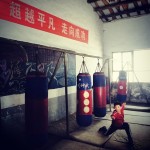Why is the Kimura Armbar called the Kimura armbar?
Well, back in 1951, Helio Gracie challenged Masahiko Kimura to a duel and lost. The Gracie clan then named the armbar used to defeat Helio after the man who used it. Tracing this bit of trivia back to its roots gives us an interesting look at the development of a martial art – Brazilian Jiu Jitsu – from its origins in feudal Japan to its current incarnation as the “invincible” mixed martial art of the day.
The end result also demonstrates the power of branding, which, according to Ben Judkins and Paul Bowman, is what most martial arts have been focused on since the late 19th century.
Helio’s jiu jitsu is a derivative of the Brazilian Jiu Jitsu practiced and taught by his brothers, who learned the art from a Kano Judo missionary, Mitsuyo Maeda. Helio’s style is generally what we see today in MMA, the slithery art of submitting that Royce Gracie used to great effect during the early days of the UFC. Helio’s style took into account his own physical frailty and produced a martial art that allowed smaller people to defeat larger, more powerful opponents through leverage and technique.
Check out this video I found on Facebook about Maeda:
Although called jiu jitsu, Helio’s brothers were in essence learning judo,a derivative of jiu jitsu developed by Kano Jigoro that incorporated as many styles and ideas as Kano could wrap his hands and mind around. Kano was an innovator, taking the many (many!) jiu jitsu styles out there and creating 柔道 or Judo, which can be translated as the Way of Softness or the Soft Art. Kano, although definitely not the first, was without question a progenitor of modern MMA in terms of his attitude toward learning martial arts (as many as possible) and his attitude towards the teacher-student relationship (anyone can be a student or a teacher at any time).
Kano sent Mitsuyo Maeda abroad, who agreed to teach Carlos Gracie, who then taught Helios. This initial “missionary work” helped judo become the first Asian martial art to make a big impact in the Western world, and also the first martial art to become an Olympic Sport.
Judo itself is an ancient term, and applies to jiu jitsu styles that were developed hundreds of years before the Gracies, in feudal Japan. The origin of the jiu jitsu martial art seems to have come about due to strict Tokugawa laws – based on Chinese Neo Confucianism – that forbade warfare. Martial arts that took into account battle between an unarmed combatant and an armored/armed combatant already existed throughout China and in Japan – in fact, one could argue that the whole idea of a martial art is to even the playing ground between the armed professional and the unarmed amateur – but they coalesced into schools and styles in Japan during the Tokugawa period.
The major difference between jiu jitsu and Chinese martial arts at the time seems to be the preference for locks, chokes, and grappling over strikes and kicks. I haven’t done the research on this, but I would like to see some evidence that shows a lack of grappling and locks in Chinese martial arts – especially during the period when jiu jitsu developed in Japan (14th – 17th centuries).
That preference distinguished jiu jitsu from other martial arts, but, like most other styles, jiu jitsu was a living art, changing and developing with each successive generation. A brief look at the history of jiu jitsu, judo, sambo and Brazilian jiu jitsu shows us that styles can morph quickly, within one generation, based upon need, environment, teacher, student, etc.
But does that make the idea of a core lineage patently false?
I don’t think so, as feudal Japanese jiu jitsu practitioners employed strikes (a la Chinese martial arts) as well as grappling and submission techniques that survived in essence all the way to Kano Judo (20th century), which in turn gave BJJ a signature move that we see all the time, the Kimura. It’s ridiculous to think that feudal jiu jitsu-trained warriors fighting for their lives against spear-wielding armored men were unaware of a Kimura armbar or a similar such debilitating move.
I would argue that a feudal warrior could recognize the moves in UFC 160 and vice versa.
Which brings me, again, to my vocal buddy Eli who once asked for a Compendium of the Martial Arts and most recently loudly argued that BJJ has little or nothing to do with Japan and even less to do with China.
Behold, the power of branding.
MMA, UFC and the Gracies have so thoroughly dominated the modern idea of martial arts, and what is effective, that the history of the arts and the beautiful complexity of ideas and practice that gave birth to a thousand and one styles has been reduced to 3-4 terms.
Grappling, Striking (feet and hands), BJJ. That’s basically it when you’re talking about modern MMA and truly, there isn’t that much more to fighting than those three general fields, right? The simplification of the styles, which has slashed the number of schools in China down to a handful from the countless folk/town/regional styles of centuries past, has also made the UFC pretty predictable. Ground and Pound, TKO to Strikes, Armbar/Legbar, or fat guy with an Ogre Bling knockout punch.
But they can’t stay in their little “this is all there is” bubble for long. Spinning heel kicks are all the vogue after Vitor and Junior employed them to devastating effect, and although Joe Rogan can exclaim that such “innovations” are great for the sport, and my buddy Eli can talk about how “once the plateau is reached it becomes the norm,” I think the truth is that these MMA guys could stand to pick up one of the old Ming manuals, or peep some feudal Japanese drawings of men vs. samurai.
Innovation may just be two parts remembering and one part circumstance.




I didn’t say “BJJ has little or nothing to do with Japan and even less to do with China.” I said that your argument that the idea that chokes and locks in modern BJJ evolved from Chinese martial arts requires substantiation.
I don’t see much elaboration here as to how locks and chokes played a role in traditional Chinese marital arts. No one disputes BJJ’s Japanese lineage. How the techniques trace back to Chinese martial arts however, remains to be seen.
I find this statement indicative of your inductive reasoning with regards to the question of lineage and influence: “I haven’t done the research on this, but I would like to see some evidence that shows a lack of grappling and locks in Chinese martial arts – especially during the period when jiu jitsu developed in Japan (14th – 17th centuries).”
So, barring evidence that there was NOT grappling in traditional Chinese martial arts, we should assume that there must have been? That is backwards logic.
How about first we gather some research as to how the locks and chokes in BJJ are similar to ancient Chinese techniques in specific ways, identify history of that evolution, then build a theory of influence.
They say to a man with a hammer, everything looks like a nail. I guess to a guy with a research project on kungfu, everything looks like a derivative thereof.
CMA without question has holds and locks and chokes, I should have clarified what i really was thinking there, which is:
I don’t know if Chinese locks have a direct influence on feudal era Japanese Jiu Jitsu, the clear ancestor of BJJ.
A little bit on locks in CMA: Qin Na is probably the best place to start. Every major Chinese style has Qin Na techniques, which are basically locks, pressure point grips, and other ways to contort the body into painful submission.
Japan absorbed so much from China: tea, religion, language, political and philosophical systems, martial arts etc that it is likely that jiu jitsu has a Chinese connection. As far as I have read however, jiu jitsu seems to be an offshoot of traditional CMA that adapted to unique Japanese conditions.
But yeah, everywhere I look in the MMA world, I see CMA techniques: strikes, kicks, locks, throws, even grappling. Wrestling seems to be more Western ie Greek/Middle Eastern …
Muy Thai and Vo Vietnam were also influenced by CMA, but still represent local adaptions. Its like religion in many ways: a lot of faiths and creation myths come from India, but as he traveled across the Fertile Crescent to the Mediterranean, Jesus’ eyes turned blue.
And that’s my major point really, that a lot of MMA fighters scoff at the trad. Asian martial arts when the source of everything they do lies in the East.
Some links:
http://www.martial-art-potential.com/joint-locks.html
http://www.thewayofshaolin.com/grappling/
http://en.wikipedia.org/wiki/Chin_Na